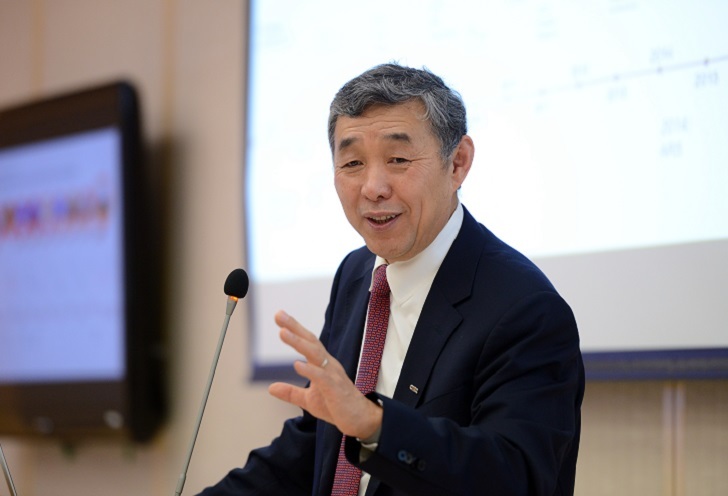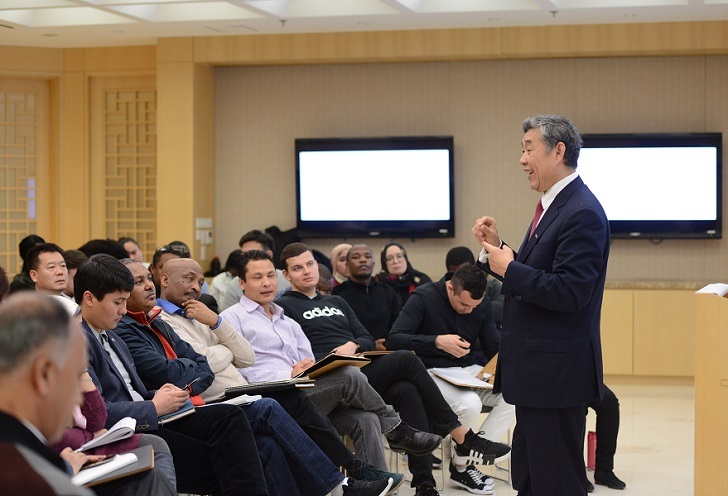Executive Education
sidenav header backgroundChina’s Energy Transition Under the Pollution Control and Climate Change

The world continues to accept reality of Climate change. The weather patterns have changed and the future looks gloomy if anthropological stand is never taken seriously. As one of the institutions that promote Green and Sustainable Development, Institute of South-South Cooperation and Development took a bold step in sensitizing the students at the institution to ensure that they go green and promote green.
Addressing vigilant participants on November 18, 2018, at the Stanford Center, Peking University, ng, an energy expert and research professor at the National Center for Climate Change Strategy and International Co-operation (NCSC) took a defining moment to explain how important it is to act in stopping climate change.
In his climate change sermon, he highlighted that the global climate system has been constantly warming with reports confirming that the average temperature of the continents and ocean surface for the period 1880 to 2012, rose to about 0.85 °C. In 2015, the average temperature in China was 10.5 °C, 0.95°C degrees higher than normal. In fact, since the birth of meteorological records, the years 2015, 2016 and 2017 were recorded as the hottest ever.
On the aquatic layers, the sea level has risen considerably over the years, while the ice cap is shrinking as large areas of glaciers at the Antarctica and the northern hemisphere are melting. Ecosystems have been destroyed placing more and more species at the verge of extinction.
Professor Li emphasized that the frequent severe climate events with greater severities experienced, had resulted to more casualties and property loss. While the rising sea level threatens the coastal and marine ecosystem, the constant water shortages intensify food insecurity. Developing countries face bigger agricultural losses, more climate disasters and severe survival crisis leading to continued mercy on poverty and struggle to economic growth.
While strolling through his presentation, he did not hesitate to point fingers to human factors as the major cause of climate change. The strong correlation between the emission of greenhouse gases resulting from human activities and increased global average temperatures is eminent. Anthropogenic GHGs have serious impact to nature. Human activities such as deforestation, burning fossil fuels (coal, petroleum, and natural gas) and some agricultural activities are associated with increased production of carbon dioxide leading to an upswing in atmospheric temperatures.
The most begging question would be how can man reverse his irresponsible attitude towards nature to ensure that climate change is tamed? Climate change mitigation generally involves actions to limit the intensity and magnitude of climate change. It entails activities geared towards the reduction of human emissions of greenhouse gases as well as actions intended to increase the capacity of carbon sinks such as reforestation.
Since the 1970s, international organizations have been engaged in climate change negotiations as mitigation is considered a public good. In 1988, the Intergovernmental Panel on Climate Change (IPCC) was founded to collate and assess evidence on climate change. Its first assessment report was produced in 1990 indicating temperatures had risen by 0.3 to 0.6C over the last century.
The Earth Summit in Rio de Janeiro in 1992 established the United Nations Framework Convention on Climate Change (UNFCCC) with the main objective of stabilizing atmospheric concentrations of GHGs to levels that would prevent dangerous human interference with the climate system. The framework set non-binding limits on GHGs emissions for individual countries and contains no enforcement mechanisms. Largely due to its nearly universal membership, the convention enjoys broad legitimacy.
Since 1995, under the auspices of the UNFCCC, the 196 parties to the convention meet annually to assess progress in dealing with climate change. The Kyoto Protocol of 1997 established legally binding obligations for developed countries to reduce their GHGs emissions by an average of 5 per cent within the period 2008–2012
The UN negotiations at Bali in 2007 gave birth to the two-year “Bali Roadmap” which was aimed at hammering out a new global treaty by the end of 2009. However, the UN climate summit in Copenhagen in the year 2009 didn’t bear much fruits. The high expectations for a new global agreement were shattered and the 192 governments had to bear with a controversial political declaration, the so-called “Copenhagen Accord”.
A major milestone in international climate change negotiations came with the adoption of the Paris Agreement, which became effective on November 4, 2016. As of January 2018, it had been approved or accepted by 174 signatories. Under the agreement, targets were set for temperature rise, mitigation, adaptation and funding. For temperature rise, the targets was to control the average global temperature rise to be within 2°C from the pre- industrialization level, and make efforts to strive for within 1.5°C. In mitigation, countries are expected to peak out as soon as possible global GHGs emission, and achieve a balance between the human GHGs emission and sinks.
The adoption target involves improving adaptability to the negative impacts from climate change, strengthening climate restoring ability without impacting food production and striving for an adaptive society. For the funding target, capital flow should follow the development path with low GHG emission and adaptability to climate.
Unlike previous agreements, the Paris Agreement adopted a “bottom up” approach where all countries are expected to propose voluntary emission reduction. The parties have to submit national voluntary emission reduction targets every five years avoiding retrogression and striving for gradually improvement in reduction.
This notwithstanding, the on-going climate change negotiations have produced little progress in preventing the ultimate objective of the Framework Convention that is to prevent dangerous anthropogenic interference with the climate system.
Professor Li argued that three overarching conflicts have overshadowed all effort for an effective agreement so far. While the first plus the second conflict is within the developing and within the developed countries, the third conflict is between developed and developing countries. The latter conflict debates the question of how much and who should reduce emissions in the future. Further, this categorization serves to demonstrate a major hurdle in establishing a common ground.
In conclusion, the professor proposed that a political consensus should be used in addressing the problem of climate change. As a consequence, for a sustainable solution every state or at least the main causers of the problem have to be included in the negotiations process to secure its effectiveness. Together, we can curb the alarming trend of climate change.

By Diana Lukalo







